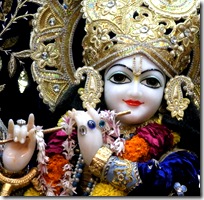 “O son of Kunti, I am the taste of water, the light of the sun and the moon, the syllable om in the Vedic mantras; I am the sound in ether and ability in man.” (Lord Krishna, Bhagavad-gita, 7.8)
“O son of Kunti, I am the taste of water, the light of the sun and the moon, the syllable om in the Vedic mantras; I am the sound in ether and ability in man.” (Lord Krishna, Bhagavad-gita, 7.8)
Question: “Do you have any concrete evidence that God exists?”
Answer: Proof of the existence of God, or a supreme divine authority figure, has been an issue since the beginning of time. There are those who simply don’t believe in a higher power, regardless of how hard they may try or want to have faith in Him. Rather, they require concrete evidence, proof of the claim that this entire creation was intelligently designed by a higher authority, someone who is immune to the effects of birth and death, heat and cold, happiness and distress. For the believers, those who have firm confidence in the existence of a singular Divine Entity, the questions pertaining to evidence supporting God’s existence certainly seem silly. The devotee sees evidence of God’s existence everywhere, at every corner of the globe and in every inch of ethereal space. Life itself is proof of spirit, for without the spiritual spark inside the body, an individual is deemed dead and useless. Just as there is life inside of a small body composed of matter, there is a more powerful life inside of the entire material cosmos. This Superior Spirit is responsible for all the workings of nature, thus any action, inward or outward, is evidence of the Supreme’s potencies. Nevertheless, there will always be skeptics, and their main bone of contention will relate to evidence. In actuality, evidence is merely a product of the material senses, and thus it can never be concrete. Rather, everyone abides by some type of faith, regardless of their spiritual persuasion. The key is to take shelter of the right kind of evidence, i.e. have faith in the right people. Following this tangible belief system ultimately leads to the greatest benefit, which is proof enough of the claims made by the faithful.
“O son of Bharata, as the sun alone illuminates all this universe, so does the living entity, one within the body, illuminate the entire body by consciousness.” (Lord Krishna, Bhagavad-gita, 13.34)
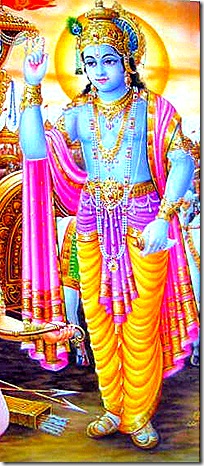 To understand the nature of evidence, let’s work through a simple example of a situation that occurs quite frequently in real life. In America and other industrialized nations, automobile accidents are quite common. For those incidents involving two motorists who are behind the wheel, the causes and effects of the crash are quite obvious. Both parties perceived with their senses the events that led to the collision. In these instances, the evidence is the eyewitness account. Other times, however, there may not be any other parties around. The hit-and-run is a not so nice part of the life of a car owner. A person parks their car in a parking lot, goes into a store or shopping mall, and then returns to see that someone has hit their car. The other driver has left the scene, so there is no evidence showing who actually committed the crime.
To understand the nature of evidence, let’s work through a simple example of a situation that occurs quite frequently in real life. In America and other industrialized nations, automobile accidents are quite common. For those incidents involving two motorists who are behind the wheel, the causes and effects of the crash are quite obvious. Both parties perceived with their senses the events that led to the collision. In these instances, the evidence is the eyewitness account. Other times, however, there may not be any other parties around. The hit-and-run is a not so nice part of the life of a car owner. A person parks their car in a parking lot, goes into a store or shopping mall, and then returns to see that someone has hit their car. The other driver has left the scene, so there is no evidence showing who actually committed the crime.
Yet sometimes there are supposed eyewitnesses who write down their observations. They will leave a note on the victim’s car which lists the culprit’s license plate number and a brief description of what occurred. What’s interesting, though, is that this note is not evidence enough to convict the accused of a crime; a fact which speaks to the nature of evidence and authority. A person could have witnessed the entire event firsthand and written about it on paper, but this description alone isn’t enough to convict, with the reason being that anyone can write anything. Any person, regardless of what they saw or didn’t see, could claim that another car hit a parked car. Sometimes the alleged criminal may even have dents and scratches on their car already. But regardless, there is always the possibility that the alleged criminal is innocent, that the person writing the note is either lying or has made a mistake. In these instances, it takes more “evidence”, or proof, to convict the criminal. Camera records are pulled and paint samples are matched. Even after finding all sorts of perceived evidence secured through an exhaustive investigation, the accusers still need to have definitive proof that the accused was driving the vehicle when the hit-and-run happened.
All of this points to the subjective nature of evidence, how it can be perceived differently by different people. Evidence is merely a recorded version of sense perceptions. A person sees, hears, tastes, smells, or touches something and then writes down their experience in a book, newspaper, website, or journal. Descriptions of the experiences can also be orally transmitted to friends, family members, and coworkers. This is how we take in all vital pieces of information. In school we read about famous figures of the past. For example, we only know that George Washington, the first President of the United States, existed because of the written evidence found in books. There are also paintings that were created, but again, the identification and authenticity of the paintings is determined by written evidence in addition to oral tradition passed down from generation to generation.
 For the skeptic, successfully nullifying evidence is very easy. Everyone is prone to making mistakes, cheating, having imperfect senses, and being easily illusioned. To ere is human after all, so every one of us can make mistakes. Sometimes you can even have photographic evidence that is disputed. For example, in the National Football League, there are instant replay reviews of many controversial calls on the field. Invariably, there will be calls in a game where the announcers, referees, and players see the same video replay and reach different conclusions as to what occurred. Again, this speaks to the fact that every person has different sense perceptions, worldviews, ulterior motives, and levels of honesty.
For the skeptic, successfully nullifying evidence is very easy. Everyone is prone to making mistakes, cheating, having imperfect senses, and being easily illusioned. To ere is human after all, so every one of us can make mistakes. Sometimes you can even have photographic evidence that is disputed. For example, in the National Football League, there are instant replay reviews of many controversial calls on the field. Invariably, there will be calls in a game where the announcers, referees, and players see the same video replay and reach different conclusions as to what occurred. Again, this speaks to the fact that every person has different sense perceptions, worldviews, ulterior motives, and levels of honesty.
So how do we determine what is evidence? A doubting soul may ask what evidence is there of God’s existence, but the same question can be posed to the original questioner. “What proof is there that you exist?” The person may retort with, “Well, I’m talking to you, aren’t I? You’re seeing me, aren’t you? Isn’t that proof enough?” This is a very obvious answer that actually gives us insight into solving the question about God. Surely we know someone exists when we see them and interact with them. Now let’s fast forward one hundred years. Both questioners are now dead, yet what proof is there that either person existed? If someone had written down their observations in a book and that book happened to be preserved for over one hundred years, then we could surely use that as evidence. Similarly, if the third party’s observations were verbally transmitted to a dependent, who then subsequently passed the same information down to other dependents, we could take that verbal affirmation as evidence of existence.
This situation validates the claim that one’s perceptions don’t diminish or increase over time. If I say that someone else exists today, my statement doesn’t lose value over time, nor does it become truer. The truth is the truth; the perception is the perception. Whether we fast forward one hundred years or ten thousand years, the sense perceptions are still the same; hence the evidence is always valid. At this point, a skeptic could question the validity of the initial perception, claiming it to be flawed. After all, everyone has made mistakes, even the greatest of scientists. There was a time when a consensus of scientists believed that the earth was flat. They were all eventually proved wrong, so in the end, their supposed evidence wasn’t proof of anything.
So how do we determine the validity and authenticity of evidence? There is no surefire way. Rather, each of us takes evidence based on authority. This authority is determined by the person accepting the evidence. Again, this speaks to the fact that evidence is subjective and something that requires faith. Therefore, for followers of the Vedic tradition, empirical evidence is not as important as the faith that is ascribed to the statements of those deemed as authority figures. What this means is that it is more important to see the results of having faith in evidence than actually arguing over the authenticity of the evidence itself.
So far this discussion is completely theoretical, so to understand the issue more clearly, let’s use the example of a set of scriptures that is currently perceivable, the Vedas. In India, the spiritual traditions date back so far that no one can actually come up with a concrete date for their inception. These traditions descend from the Vedas, scriptural works which purportedly come from God. The Vedas have no date of inception because God Himself is eternal. The concepts of time and space are merely products of the material world representing the limits to the thinking abilities of the human brain. In the spiritual world, there is no such thing as time and space, or at least their influences are completely irrelevant. Therefore God, and anything He creates, including knowledge, has no beginning and no end.
“Whenever and wherever there is a decline in religious practice, O descendant of Bharata, and a predominant rise of irreligion-at that time I descend Myself.” (Lord Krishna, Bg. 4.7)
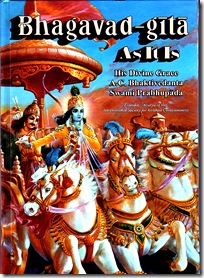 The Vedas not only inform us of God’s existence but also of His various descents to the world that we currently inhabit. These appearances are for the purposes of annihilating miscreants and pleasing devotees, those conditioned souls who sincerely desire the association of the Supreme Spirit. Each time the Lord comes to earth, He assumes a different visible transcendental form and takes to different activities. In days past, the sense perceptions of those who were around during the Lord’s descents to earth were passed down through an oral tradition. Later on, these same accounts were written down into wonderful epics such as the Ramayana, Mahabharata, and Puranas. These books themselves are evidence of God’s existence. Mostly authored by Vyasadeva, the classic Vedic texts describe in great detail God’s names, forms, pastimes, appearances, associates, family members, and the geographical locations of His noteworthy activities.
The Vedas not only inform us of God’s existence but also of His various descents to the world that we currently inhabit. These appearances are for the purposes of annihilating miscreants and pleasing devotees, those conditioned souls who sincerely desire the association of the Supreme Spirit. Each time the Lord comes to earth, He assumes a different visible transcendental form and takes to different activities. In days past, the sense perceptions of those who were around during the Lord’s descents to earth were passed down through an oral tradition. Later on, these same accounts were written down into wonderful epics such as the Ramayana, Mahabharata, and Puranas. These books themselves are evidence of God’s existence. Mostly authored by Vyasadeva, the classic Vedic texts describe in great detail God’s names, forms, pastimes, appearances, associates, family members, and the geographical locations of His noteworthy activities.
“Abandon all varieties of religion and just surrender unto Me. I shall deliver you from all sinful reaction. Do not fear.” (Lord Krishna, Bg. 18.66)
Simply based off Vyasadeva’s writings, we have loads of evidence of God’s existence and His teachings. Though Vedic wisdom is quite comprehensive, the ultimate instruction is that one should simply surrender unto the Lord in His personal form as Krishna and be freed from all sins. In addition, Krishna has multitudes of non-different forms such as Vishnu, Rama, Narasimha, and Chaitanya, which can also be surrendered to. Though the events documented in Vyasadeva’s works occurred many thousands of years ago, there is no reason to doubt their ever having taken place. The exploits of Shri Krishna and Lord Rama are so widely known that they are documented in many books, not just one or two.
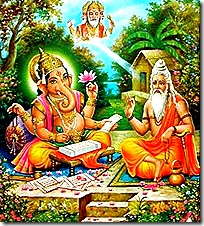 At this point, the skeptic will argue that since the evidence provided by Vyasadeva describes events of the paranormal, such as talking monkeys and children lifting gigantic hills, it must be mythology or something untrue. In addition, the fact that no one can accurately date these events should only further discredit their authenticity. Some can’t even fathom that a single entity, one man, Vyasadeva, could have written so much in one lifetime. Therefore they even doubt the authenticity and existence of such a person. This behavior is quite humorous, as Vyasadeva’s greatness and authenticity of authorship is mentioned within the works themselves by exalted sages and respectable personalities.
At this point, the skeptic will argue that since the evidence provided by Vyasadeva describes events of the paranormal, such as talking monkeys and children lifting gigantic hills, it must be mythology or something untrue. In addition, the fact that no one can accurately date these events should only further discredit their authenticity. Some can’t even fathom that a single entity, one man, Vyasadeva, could have written so much in one lifetime. Therefore they even doubt the authenticity and existence of such a person. This behavior is quite humorous, as Vyasadeva’s greatness and authenticity of authorship is mentioned within the works themselves by exalted sages and respectable personalities.
As mentioned before, a sense observation doesn’t lose its validity over time. Just because Vyasadeva wrote the Mahabharata thousands of years ago doesn’t mean that the events described within didn’t happen. Indeed, he even carefully noted down the distinct constellation of stars prior to the famous Bharata War. Analyzing the movements of stars, some scientists have deduced that such a constellation could only have occurred a long time in the past. If we think about it, it’s ironic that the people doubting the authenticity of Rama and Krishna can only raise such doubts because they know of both personalities. For instance, how can we doubt that someone exists when we know who they are, where they were born, what they look like, and when they appeared on earth? High court judges and scholars have concluded that there is no tangible evidence to prove Lord Rama existed, but is not the Ramayana evidence enough? Maharishi Valmiki met Lord Rama and wrote down his observations in a very lengthy Sanskrit poem. Moreover, Rama’s existence is validated in countless other classic Vedic texts. What need is there to prove anything? Rather, how do we even know that these scholars and high court judges exist? In a few hundred years, through the use of skepticism, others can similarly doubt that these past silly judgments were ever made.
“Rama is like a mad elephant in battle. He has a purified and unblemished family lineage for His trunk, brilliance and splendor for His excitement, and two powerful arms for tusks. O Ravana, you are not even qualified to look at Him.” (Maricha speaking to Ravana, Valmiki Ramayana, Aranya Kand, 31.46)
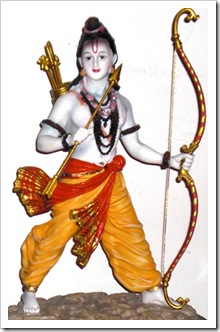 Many people saw Krishna and Rama directly and still didn’t believe that they were God. Such individuals didn’t even have to rely on the written word of Vyasadeva or the claims of evidence provided by others; they got to experience God’s splendor directly. During Lord Rama’s time, the Rakshasa demon Ravana failed to acknowledge Rama’s divine nature. The Rakshasa Maricha on one occasion had attacked the venerable Vishvamitra Muni during the time of a sacrifice. Rama, at the time a young child, was there with Vishvamitra to protect him. Shooting an arrow at Maricha, Rama launched the demon hundreds of miles away into an ocean. Thus Maricha had firsthand knowledge of Rama’s supreme powers. He subsequently warned Ravana not to anger the Lord or fight against Him. Maricha’s words were evidence of Rama’s divine nature, yet Ravana refused to accept them. In the end, this denial would cost him his royal opulence, worldwide fame, position as an object of fear, and ultimately, his life.
Many people saw Krishna and Rama directly and still didn’t believe that they were God. Such individuals didn’t even have to rely on the written word of Vyasadeva or the claims of evidence provided by others; they got to experience God’s splendor directly. During Lord Rama’s time, the Rakshasa demon Ravana failed to acknowledge Rama’s divine nature. The Rakshasa Maricha on one occasion had attacked the venerable Vishvamitra Muni during the time of a sacrifice. Rama, at the time a young child, was there with Vishvamitra to protect him. Shooting an arrow at Maricha, Rama launched the demon hundreds of miles away into an ocean. Thus Maricha had firsthand knowledge of Rama’s supreme powers. He subsequently warned Ravana not to anger the Lord or fight against Him. Maricha’s words were evidence of Rama’s divine nature, yet Ravana refused to accept them. In the end, this denial would cost him his royal opulence, worldwide fame, position as an object of fear, and ultimately, his life.
“Anyone could understand that he was just like someone onstage playing the part of Vasudeva in false dress. When Lord Shri Krishna saw Paundraka imitating His posture and dress, He could not check His laughter, and thus He laughed with great satisfaction.” (Krishna, The Supreme Personality of Godhead, Vol 2, Ch 11)
Similarly, there was an imposter king named Paundraka during Lord Krishna’s time who was claiming to be the real Vasudeva, which is another name for Krishna. He claimed that the real Krishna was simply a fake and that He needed to stop pretending to be God. So this fool saw Lord Krishna in person and still refused to accept Him as the Supreme Personality of Godhead. The Lord would go on to teach this imposter a lesson, but this incident further illustrates the fact that for those who want to remain in the material world and pretend to be God themselves, no amount of evidence, visual or otherwise, is sufficient enough to prove the authenticity of God’s existence.
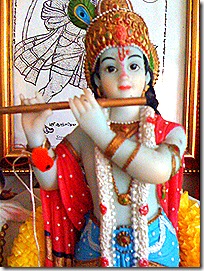 For every individual, the authenticity of evidence is always determined by faith and authority. We view a person or entity as authoritative and thus believe whatever evidence they present to us. This is indeed the same tact followed by the devotees of Krishna. A follower of the Vedic tradition takes Vyasadeva, Valmiki, and other great saints as authority figures. Whatever evidence they provide is willingly accepted. But more important than evidence and faith is the action that is taken as a result. The unmatched, fixed transcendental position achieved by those who follow the prescriptions of the authorized acharyas is evidence enough of the authenticity of the Vedas and their founder.
For every individual, the authenticity of evidence is always determined by faith and authority. We view a person or entity as authoritative and thus believe whatever evidence they present to us. This is indeed the same tact followed by the devotees of Krishna. A follower of the Vedic tradition takes Vyasadeva, Valmiki, and other great saints as authority figures. Whatever evidence they provide is willingly accepted. But more important than evidence and faith is the action that is taken as a result. The unmatched, fixed transcendental position achieved by those who follow the prescriptions of the authorized acharyas is evidence enough of the authenticity of the Vedas and their founder.
To illustrate this point more clearly, let’s review some common behavioral traits exhibited by the average person. Surely “average” can mean anything, but with this example, the behavior can apply to any person, regardless of their belief in God or lack thereof. When the average person leaves the home in the morning, they are placing faith in their fellow man to not harm them. Based on their experiences of days past – sense perceptions which have since been stored in memory – the individual leaving the home has faith that no one will kill them, run into them with their car, or attack them when they step out the door. When such a person is driving to work in their car, they have faith that other drivers will adhere to the traffic laws, especially when travelling through a green light. When we drive through an intersection with a green light, it means that the crossing traffic has a red light, which is an indication to stop. If a driver who is on the crossing side does not adhere to this red light, they will enter the intersection at the same time that the other cars are passing. Hence a fatal accident could easily occur. But the first driver has faith, based on past empirical evidence, that the drivers on the other side will adhere to their red light. As mentioned before, every person is bound to make mistakes and perceive things incorrectly. Therefore there is no one hundred percent guarantee that every other driver will adhere to red lights and stop signs.
 We willingly drive through intersections with green lights because we have faith in the previous evidence that was accumulated. This practice, when attached to the right type of evidence, can actually unlock the secret to the spiritual kingdom. Every one of us takes to activity with a desired positive outcome in mind. The nature of the positive condition can vary, but the end-goal is that of a favorable situation. When activities eventually lead to their intended goal, we develop faith in the evidence that served as the impetus for taking up that activity. In this way, we see that the only way to prove God’s existence is to take to the activities that He prescribes. For the people of this age, the great Vaishnava authorities, the devotees who have a firm belief in the existence of Lord Vishnu [Krishna] and His avataras, recommend that we all take to bhakti-yoga, or devotional service, as a way of life. The quintessential act of bhakti is the chanting of the holy names of the Lord, “Hare Krishna Hare Krishna, Krishna Krishna, Hare Hare, Hare Rama Hare Rama, Rama Rama, Hare Hare”. Along with abstaining from meat eating, gambling, intoxication, and illicit sex, the assertive processes of devotional service will lead to the most favorable of conditions. Since these activities bring about a change of consciousness, they lead to the emancipation of the soul, the release from the cycle of birth and death.
We willingly drive through intersections with green lights because we have faith in the previous evidence that was accumulated. This practice, when attached to the right type of evidence, can actually unlock the secret to the spiritual kingdom. Every one of us takes to activity with a desired positive outcome in mind. The nature of the positive condition can vary, but the end-goal is that of a favorable situation. When activities eventually lead to their intended goal, we develop faith in the evidence that served as the impetus for taking up that activity. In this way, we see that the only way to prove God’s existence is to take to the activities that He prescribes. For the people of this age, the great Vaishnava authorities, the devotees who have a firm belief in the existence of Lord Vishnu [Krishna] and His avataras, recommend that we all take to bhakti-yoga, or devotional service, as a way of life. The quintessential act of bhakti is the chanting of the holy names of the Lord, “Hare Krishna Hare Krishna, Krishna Krishna, Hare Hare, Hare Rama Hare Rama, Rama Rama, Hare Hare”. Along with abstaining from meat eating, gambling, intoxication, and illicit sex, the assertive processes of devotional service will lead to the most favorable of conditions. Since these activities bring about a change of consciousness, they lead to the emancipation of the soul, the release from the cycle of birth and death.
“My dear Arjuna, only by undivided devotional service can I be understood as I am, standing before you, and can thus be seen directly. Only in this way can you enter into the mysteries of My understanding.” (Lord Krishna, Bg. 11.54)
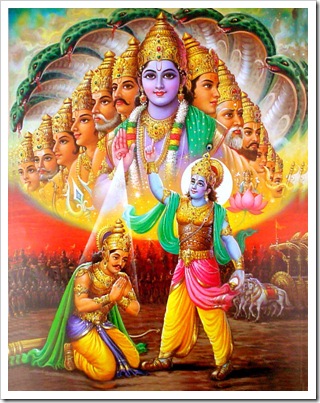 Everyone is looking for some pleasure, but the practices commonly adopted to secure such enjoyment fail in every regard. Even the engagements that do bring about some temporary happiness are riddled with negative side effects. The evidence provided by Vyasadeva and the Vedas in general are not meant to be accepted blindly. As mentioned before, any evidence, regardless of how obvious it may seem, can be invalidated through the use of skepticism. Therefore we should have some faith in the beginning and take to the recommended processes that constitute bhakti-yoga. Arjuna, Lord Krishna's dear friend, was always in the mindset of bhakti, so he was able to see Krishna for who He was, the Supreme Personality of Godhead. The proof is in the pudding, so if we follow the instructions of the spiritual masters and the Supreme Lord Himself, we will soon be able to tell for ourselves if the Vedas are authentic and if Krishna really is the ultimate reservoir of pleasure.
Everyone is looking for some pleasure, but the practices commonly adopted to secure such enjoyment fail in every regard. Even the engagements that do bring about some temporary happiness are riddled with negative side effects. The evidence provided by Vyasadeva and the Vedas in general are not meant to be accepted blindly. As mentioned before, any evidence, regardless of how obvious it may seem, can be invalidated through the use of skepticism. Therefore we should have some faith in the beginning and take to the recommended processes that constitute bhakti-yoga. Arjuna, Lord Krishna's dear friend, was always in the mindset of bhakti, so he was able to see Krishna for who He was, the Supreme Personality of Godhead. The proof is in the pudding, so if we follow the instructions of the spiritual masters and the Supreme Lord Himself, we will soon be able to tell for ourselves if the Vedas are authentic and if Krishna really is the ultimate reservoir of pleasure.
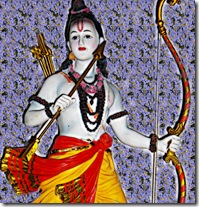 “When angered, Raghava is capable of bringing the entire world, including all devas, asuras, and Gandharvas, under His control simply by taking up His bow.” (Hanuman speaking to Sugriva, Valmiki Ramayana, Kishkindha Kand, 32.19)
“When angered, Raghava is capable of bringing the entire world, including all devas, asuras, and Gandharvas, under His control simply by taking up His bow.” (Hanuman speaking to Sugriva, Valmiki Ramayana, Kishkindha Kand, 32.19)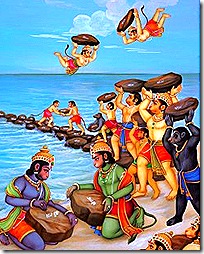 In this particular instance, the areas of interest relate to a kingdom and all the opulences that come with it. Many thousands of years ago, the forest dwellers in Kishkindha were basking in the reacquisition of a lost kingdom. During those times, the forest inhabitants were known as Vanaras, which is a Sanskrit word which means “of the forest.” Since these events took place so long ago, the species residing in the forests weren’t necessarily human beings or monkeys. The Vanaras were a combination of both; not some mythological creatures, but rather, a species specific to the time period. According to Vedic information, the varieties in species are caused by the innumerable combinations of material qualities that souls accept upon entry into the temporary creation. The only permanent creation exists in the spiritual sky, a realm where the Lord in His original form and His liberated associates enjoy each other’s company. The temporary creation is the world that we currently inhabit, a place full of misery, duality, and heartache. Since every soul has different desires to act out on this temporary playground, they are each given bodies with different qualities to make use of. The Vanaras of the Treta Yuga were one particular type of species who primarily possessed monkey-like characteristics, along with the ability to speak and take in knowledge.
In this particular instance, the areas of interest relate to a kingdom and all the opulences that come with it. Many thousands of years ago, the forest dwellers in Kishkindha were basking in the reacquisition of a lost kingdom. During those times, the forest inhabitants were known as Vanaras, which is a Sanskrit word which means “of the forest.” Since these events took place so long ago, the species residing in the forests weren’t necessarily human beings or monkeys. The Vanaras were a combination of both; not some mythological creatures, but rather, a species specific to the time period. According to Vedic information, the varieties in species are caused by the innumerable combinations of material qualities that souls accept upon entry into the temporary creation. The only permanent creation exists in the spiritual sky, a realm where the Lord in His original form and His liberated associates enjoy each other’s company. The temporary creation is the world that we currently inhabit, a place full of misery, duality, and heartache. Since every soul has different desires to act out on this temporary playground, they are each given bodies with different qualities to make use of. The Vanaras of the Treta Yuga were one particular type of species who primarily possessed monkey-like characteristics, along with the ability to speak and take in knowledge.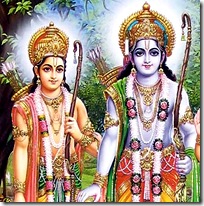 Sugriva, taking shelter in the forest of Kishkindha, a place where Vali was forbidden from entering, had the good fortune of meeting Shri Rama and His younger brother Lakshmana. Rama and Lakshmana are famous throughout India today, as is Hanuman. Rama is considered an incarnation of Godhead, a primary avatara of Lord Vishnu. Vishnu, Krishna, Rama, and Narayana are interchangeable names for the person the rest of the world refers to as God. These names are more descriptive than the name “God” because they reference specific attributes and transcendental qualities possessed by the Lord. In the case of Rama, the name also refers to a specific incarnation of Godhead who appeared on earth and enacted wonderful pastimes.
Sugriva, taking shelter in the forest of Kishkindha, a place where Vali was forbidden from entering, had the good fortune of meeting Shri Rama and His younger brother Lakshmana. Rama and Lakshmana are famous throughout India today, as is Hanuman. Rama is considered an incarnation of Godhead, a primary avatara of Lord Vishnu. Vishnu, Krishna, Rama, and Narayana are interchangeable names for the person the rest of the world refers to as God. These names are more descriptive than the name “God” because they reference specific attributes and transcendental qualities possessed by the Lord. In the case of Rama, the name also refers to a specific incarnation of Godhead who appeared on earth and enacted wonderful pastimes.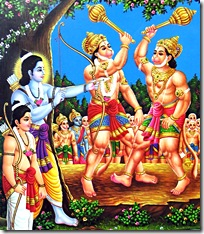 Upon reaching Kishkindha, a meeting between Rama and Sugriva was brokered by Hanuman, Sugriva’s chief minister. This meeting then led to an alliance, a sort of implied agreement. Sugriva wanted to regain his kingdom from Vali and Rama wanted to find His wife. Both agreed to help each other out with what they needed. Lord Rama held up His end of the bargain. Sugriva challenged Vali to a fight, and while the monkeys were engaged in battle, Rama shot Vali in the back with an arrow. Upon the monkey’s death, Sugriva and his subjects regained their kingdom.
Upon reaching Kishkindha, a meeting between Rama and Sugriva was brokered by Hanuman, Sugriva’s chief minister. This meeting then led to an alliance, a sort of implied agreement. Sugriva wanted to regain his kingdom from Vali and Rama wanted to find His wife. Both agreed to help each other out with what they needed. Lord Rama held up His end of the bargain. Sugriva challenged Vali to a fight, and while the monkeys were engaged in battle, Rama shot Vali in the back with an arrow. Upon the monkey’s death, Sugriva and his subjects regained their kingdom.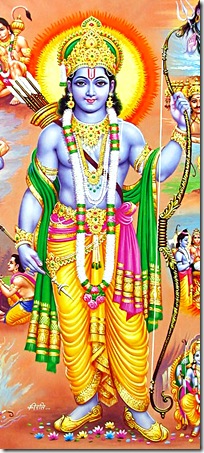 In the above referenced quote, Hanuman is reminding Sugriva of Rama’s powers. Hanuman, who is a pure devotee of Shri Rama, knows the Lord very well. Hanuman never thinks of anyone else, so he never fails to remember Rama’s potencies. Lord Rama is generally depicted as very happy, wearing a pleasing smile on His face. He is God after all, so why wouldn’t He be happy? Yet here Hanuman is reminding Sugriva that Rama can also get angry if need be. It was through the Lord’s fighting prowess that Sugriva was able to enjoy the happiness that he was currently basking in. Therefore it was incumbent upon the monkey-king to hold up his end of the bargain. Lord Rama, as the most powerful warrior the world had ever seen, was not only capable of killing Vali and others, but He was capable of destroying the entire creation, including the residents of different planets. The demigods are the pious elevated living entities who reside in the heavenly planets. The asuras are the demons; they generally reside in the lower hellish planets. The Gandharvas are the celestial singers who entertain the demigods in heaven with their sweet songs. Lord Rama was so powerful that He could bring all of these entities under His control simply by shooting one arrow from His bow.
In the above referenced quote, Hanuman is reminding Sugriva of Rama’s powers. Hanuman, who is a pure devotee of Shri Rama, knows the Lord very well. Hanuman never thinks of anyone else, so he never fails to remember Rama’s potencies. Lord Rama is generally depicted as very happy, wearing a pleasing smile on His face. He is God after all, so why wouldn’t He be happy? Yet here Hanuman is reminding Sugriva that Rama can also get angry if need be. It was through the Lord’s fighting prowess that Sugriva was able to enjoy the happiness that he was currently basking in. Therefore it was incumbent upon the monkey-king to hold up his end of the bargain. Lord Rama, as the most powerful warrior the world had ever seen, was not only capable of killing Vali and others, but He was capable of destroying the entire creation, including the residents of different planets. The demigods are the pious elevated living entities who reside in the heavenly planets. The asuras are the demons; they generally reside in the lower hellish planets. The Gandharvas are the celestial singers who entertain the demigods in heaven with their sweet songs. Lord Rama was so powerful that He could bring all of these entities under His control simply by shooting one arrow from His bow.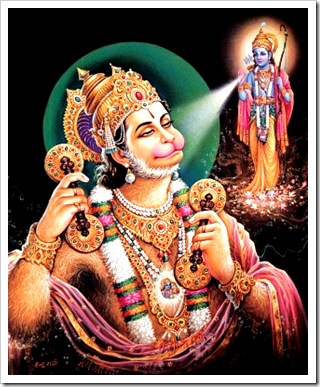 The ball is now in our court. Sugriva, upon hearing Hanuman’s words, decided to kindly pacify Lakshmana and pay back the debts owed to Shri Rama. Sugriva was eternally benefitted as a result, for Rama was able to find Sita , kill her abductor, and return triumphantly to His kingdom with all His friends and associates. Sugriva not only regained his kingdom, but through his service to Rama, he became famous throughout the world as a great devotee. For the conditioned entities living in the present, there is no reason to forget Rama or His powers. Currently our devotion is directed elsewhere towards objects which are nothing more than transformations of matter. Since God is the creator, maintainer, and destroyer of that matter, we would be better served shifting our devotion towards Him. There is no need to forget the all-powerful and all-merciful Lord. He is kindly awaiting our service and our subsequent return to His spiritual abode.
The ball is now in our court. Sugriva, upon hearing Hanuman’s words, decided to kindly pacify Lakshmana and pay back the debts owed to Shri Rama. Sugriva was eternally benefitted as a result, for Rama was able to find Sita , kill her abductor, and return triumphantly to His kingdom with all His friends and associates. Sugriva not only regained his kingdom, but through his service to Rama, he became famous throughout the world as a great devotee. For the conditioned entities living in the present, there is no reason to forget Rama or His powers. Currently our devotion is directed elsewhere towards objects which are nothing more than transformations of matter. Since God is the creator, maintainer, and destroyer of that matter, we would be better served shifting our devotion towards Him. There is no need to forget the all-powerful and all-merciful Lord. He is kindly awaiting our service and our subsequent return to His spiritual abode.
 “Intelligent persons who are endeavoring for liberation from old age and death take refuge in Me in devotional service. They are actually Brahman because they entirely know everything about transcendental and fruitive activities.” (Lord Krishna, Bhagavad-gita, 7.29)
“Intelligent persons who are endeavoring for liberation from old age and death take refuge in Me in devotional service. They are actually Brahman because they entirely know everything about transcendental and fruitive activities.” (Lord Krishna, Bhagavad-gita, 7.29) The Vedas, the ancient scriptures of India, teach one very important lesson to aspiring transcendentalists. This instruction is put forth right at the beginning, before the student goes any further in their studies. Aham brahmasmi, which means “I am Brahman.”, serves as the first lesson because it helps us understand that we have something in common with every form of life, regardless of the type of body they occupy. There is only one God, but since His potency is so great, He gives off transcendental sparks that are individually autonomous. Since these sparks come from the original fire, there is a natural affinity towards association with the reservoir of energy. Yet the qualities of free-will and independence bring about choices for the sparks. The autonomous entities may not always choose to associate with their intimate life partner, the Supreme Lord. Those who choose against the reservoir of spiritual energy are allowed to take birth in a realm which has nothing to do with God, save for His presence as an impartial observer.
The Vedas, the ancient scriptures of India, teach one very important lesson to aspiring transcendentalists. This instruction is put forth right at the beginning, before the student goes any further in their studies. Aham brahmasmi, which means “I am Brahman.”, serves as the first lesson because it helps us understand that we have something in common with every form of life, regardless of the type of body they occupy. There is only one God, but since His potency is so great, He gives off transcendental sparks that are individually autonomous. Since these sparks come from the original fire, there is a natural affinity towards association with the reservoir of energy. Yet the qualities of free-will and independence bring about choices for the sparks. The autonomous entities may not always choose to associate with their intimate life partner, the Supreme Lord. Those who choose against the reservoir of spiritual energy are allowed to take birth in a realm which has nothing to do with God, save for His presence as an impartial observer.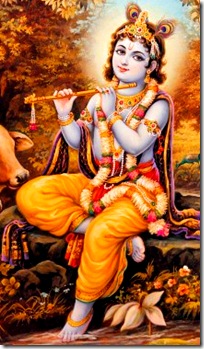 The sunshine emanates from the sun, so it can be considered non-different from the original solar body. There is no difference in the constitutional makeup between one ray of sunshine and another. Yet the sunshine is not nearly as powerful as the sun. The sunshine’s potency can also be covered up and clouded by other material elements. Though the constitutional makeup of the sunshine never changes, its autonomous nature is checked in a way by the material elements. The sun, however, is never checked. One may be able to block out the effects of the sun for a short period of time, but the sun itself remains exactly in the same position. No one is able to move it.
The sunshine emanates from the sun, so it can be considered non-different from the original solar body. There is no difference in the constitutional makeup between one ray of sunshine and another. Yet the sunshine is not nearly as powerful as the sun. The sunshine’s potency can also be covered up and clouded by other material elements. Though the constitutional makeup of the sunshine never changes, its autonomous nature is checked in a way by the material elements. The sun, however, is never checked. One may be able to block out the effects of the sun for a short period of time, but the sun itself remains exactly in the same position. No one is able to move it.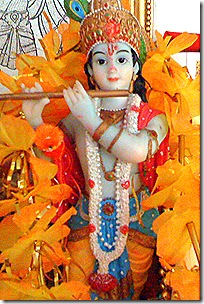 Upon realizing Brahman, there is no more hankering or lamenting. Hankering is a result of the desire for some personal benefit, and lamentation comes from failing to achieve whatever was hankered after. Since the outer body is always changing and is subject to eventual destruction, there is no reason to hanker or lament over anything related to it. Rather, the aim of life should be to reunite with the spiritual sun, Shri Krishna. In the Vedic tradition, the one and only God is referred to by many names, each of which speaks to His innumerable transcendental attributes. For a husband, there is great joy derived from hearing his beloved call him by his name. The name is much more personal and indicative of the loving thoughts shared by the paramour. In the same way, addressing God by His different names shows signs of transcendental love directed at the Supreme Loveable Object.
Upon realizing Brahman, there is no more hankering or lamenting. Hankering is a result of the desire for some personal benefit, and lamentation comes from failing to achieve whatever was hankered after. Since the outer body is always changing and is subject to eventual destruction, there is no reason to hanker or lament over anything related to it. Rather, the aim of life should be to reunite with the spiritual sun, Shri Krishna. In the Vedic tradition, the one and only God is referred to by many names, each of which speaks to His innumerable transcendental attributes. For a husband, there is great joy derived from hearing his beloved call him by his name. The name is much more personal and indicative of the loving thoughts shared by the paramour. In the same way, addressing God by His different names shows signs of transcendental love directed at the Supreme Loveable Object.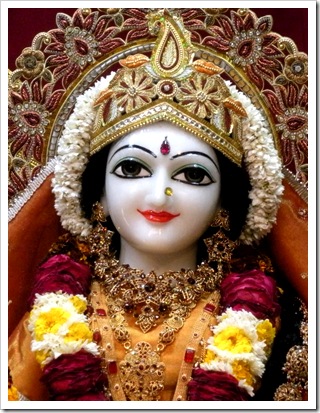 When the Brahman classification is adopted, a bond with our fellow man can immediately be formed and the chanting of the Lord’s names can collectively commence. Along with chanting, there are other processes such as worshiping, hearing, and remembering. When the processes are taken together, or if only one process is exclusively adopted, we get the discipline of bhakti-yoga, or
When the Brahman classification is adopted, a bond with our fellow man can immediately be formed and the chanting of the Lord’s names can collectively commence. Along with chanting, there are other processes such as worshiping, hearing, and remembering. When the processes are taken together, or if only one process is exclusively adopted, we get the discipline of bhakti-yoga, or  “You know that living entities are always coming and going, and thus their lives are temporary. Therefore, the learned people of this world take to performing prescribed worldly duties which yield auspicious results.” (Hanuman speaking to Tara,
“You know that living entities are always coming and going, and thus their lives are temporary. Therefore, the learned people of this world take to performing prescribed worldly duties which yield auspicious results.” (Hanuman speaking to Tara, 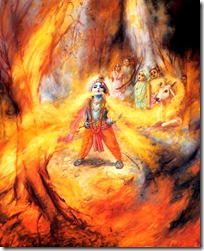 Learning of the heat properties of fire can illustrate the difference between the two processes quite clearly. A young child can discover that fire is hot by touching it. Certainly this will cause a little pain, but that comes with the territory when acquiring knowledge. Yet just because a single instance of fire is hot, it doesn’t mean that all fire is hot. Therefore the same child can go on repeating the same tests over and over again, continually burning themselves, until they realize that all fire is hot. This is knowledge acquired through the ascending process. The descending process would have provided the same information to the child without any of the painful burns. A wise person could tell a young child that fire is hot and to avoid touching it. Simply accepting this wisdom, the child can gain a perfect understanding of the properties of fire without much endeavor.
Learning of the heat properties of fire can illustrate the difference between the two processes quite clearly. A young child can discover that fire is hot by touching it. Certainly this will cause a little pain, but that comes with the territory when acquiring knowledge. Yet just because a single instance of fire is hot, it doesn’t mean that all fire is hot. Therefore the same child can go on repeating the same tests over and over again, continually burning themselves, until they realize that all fire is hot. This is knowledge acquired through the ascending process. The descending process would have provided the same information to the child without any of the painful burns. A wise person could tell a young child that fire is hot and to avoid touching it. Simply accepting this wisdom, the child can gain a perfect understanding of the properties of fire without much endeavor.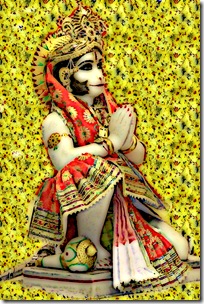 So what does the pandita do? What activities does he take to? How are these activities any different from the ones performed by those who aren’t panditas? For the answer, we can tap into the storehouse of information provided by the great spiritual leaders of the past. Using the descending process to our advantage, we can find out how to achieve perfection in life simply by following the authorized instructions provided by acharyas, or those who lead by example. One such wise person is Shri Hanuman, the faithful servant of
So what does the pandita do? What activities does he take to? How are these activities any different from the ones performed by those who aren’t panditas? For the answer, we can tap into the storehouse of information provided by the great spiritual leaders of the past. Using the descending process to our advantage, we can find out how to achieve perfection in life simply by following the authorized instructions provided by acharyas, or those who lead by example. One such wise person is Shri Hanuman, the faithful servant of 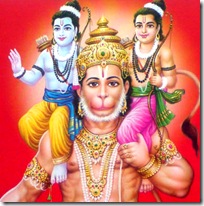 While Krishna is the reservoir of all pleasure and sweetness and other aspects of the Divine are typically viewed in a reverential mood, Lord Rama is somewhere in between. He certainly can be revered for His great power and dedication to piety, but at the same time, He can exchange heartfelt affection with the purified souls, the great devotees. Arguably Rama’s greatest devotee is Lord Hanuman, a liberated soul who takes the form of an enchanting monkey. During Rama’s time on earth, Hanuman got to personally offer his service to Rama, exchanging love in the moods of friendship and servitude.
While Krishna is the reservoir of all pleasure and sweetness and other aspects of the Divine are typically viewed in a reverential mood, Lord Rama is somewhere in between. He certainly can be revered for His great power and dedication to piety, but at the same time, He can exchange heartfelt affection with the purified souls, the great devotees. Arguably Rama’s greatest devotee is Lord Hanuman, a liberated soul who takes the form of an enchanting monkey. During Rama’s time on earth, Hanuman got to personally offer his service to Rama, exchanging love in the moods of friendship and servitude.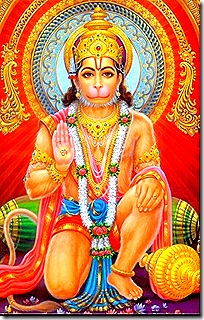 This point is quite interesting. Normally, when faced with the idea of certain death, the tendency is to take to the opposite of prescribed duties. The saying, “You only live once”, is often invoked by those who take to a carefree lifestyle, not worrying about their death that may come at any minute. The logic behind such behavior is that if death is going to come, why not enjoy as much as possible before then? From Hanuman’s statement, we see that the wise take the exact opposite approach. Since human beings are always coming and going, it must mean that death is not the end for them. After all, where do these new births come from? These souls must have been alive before to have taken birth again. This may seem like a dogmatic belief of
This point is quite interesting. Normally, when faced with the idea of certain death, the tendency is to take to the opposite of prescribed duties. The saying, “You only live once”, is often invoked by those who take to a carefree lifestyle, not worrying about their death that may come at any minute. The logic behind such behavior is that if death is going to come, why not enjoy as much as possible before then? From Hanuman’s statement, we see that the wise take the exact opposite approach. Since human beings are always coming and going, it must mean that death is not the end for them. After all, where do these new births come from? These souls must have been alive before to have taken birth again. This may seem like a dogmatic belief of 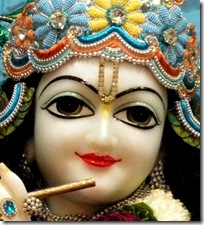 For the people living in this age, the Kali Yuga, adherence to all the rules and regulations is not possible. Life is very hectic, with so many things begging for our attention and taking up our time. Therefore,
For the people living in this age, the Kali Yuga, adherence to all the rules and regulations is not possible. Life is very hectic, with so many things begging for our attention and taking up our time. Therefore, 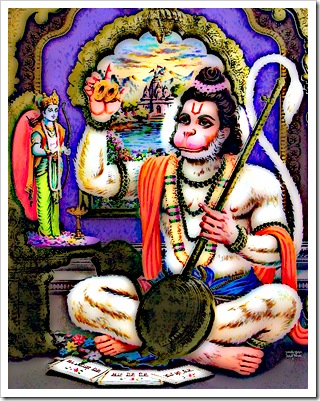 A person may be considered wise based on their mastery of a particular field. Great souls like Hanuman, however, are true panditas, the most learned among us, due to their transcendental knowledge and the activities taken up as a result of possessing that information. The panditas have laid the groundwork for us, so we simply have to accept the knowledge descending from their lotus mouths and act accordingly. The highest prescribed duty for the people of any age is to engage in bhakti-yoga, or
A person may be considered wise based on their mastery of a particular field. Great souls like Hanuman, however, are true panditas, the most learned among us, due to their transcendental knowledge and the activities taken up as a result of possessing that information. The panditas have laid the groundwork for us, so we simply have to accept the knowledge descending from their lotus mouths and act accordingly. The highest prescribed duty for the people of any age is to engage in bhakti-yoga, or 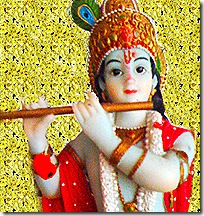 “Krishna does not change His constitutional position, not even when He appears in this material world. Ordinary living entities have their constitutional spiritual positions covered. They appear in different bodies, and under the different bodily concepts of life they act. But Krishna does not change His body.” (The Nectar of Devotion, Ch 51)
“Krishna does not change His constitutional position, not even when He appears in this material world. Ordinary living entities have their constitutional spiritual positions covered. They appear in different bodies, and under the different bodily concepts of life they act. But Krishna does not change His body.” (The Nectar of Devotion, Ch 51)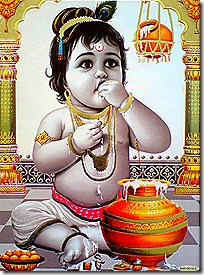 “How can God take birth?” This is an appropriate question put forth by both friend and foe alike, the inquisitive and the challengers of the authenticity and validity of the truths espoused by the Vedas. The birth and death of the individual is not difficult to comprehend. There is a spirit soul that gets placed inside of a very tiny body, which then grows while in the womb of a mother. After exiting the womb, this new body then gradually develops, exists for some time, leaves some byproducts, and then ultimately gets destroyed. Throughout these events, the identity of the individual doesn’t change. Rather, only the outer covering of the soul shifts. At the time of death, the same individual is placed inside of a new body, where they subsequently go through the same cycle of life all over again. If, however, the individual’s consciousness is purified at the time of death, they get to return to the spiritual realm, a land where birth and death do not take place.
“How can God take birth?” This is an appropriate question put forth by both friend and foe alike, the inquisitive and the challengers of the authenticity and validity of the truths espoused by the Vedas. The birth and death of the individual is not difficult to comprehend. There is a spirit soul that gets placed inside of a very tiny body, which then grows while in the womb of a mother. After exiting the womb, this new body then gradually develops, exists for some time, leaves some byproducts, and then ultimately gets destroyed. Throughout these events, the identity of the individual doesn’t change. Rather, only the outer covering of the soul shifts. At the time of death, the same individual is placed inside of a new body, where they subsequently go through the same cycle of life all over again. If, however, the individual’s consciousness is purified at the time of death, they get to return to the spiritual realm, a land where birth and death do not take place.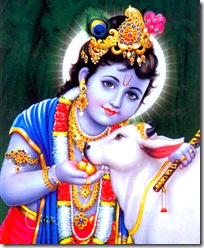 The nature of the material realm is very difficult to understand. Therefore the human body is considered the most beneficial due to the heightened potential for intelligence. Only in the human form of life can a spirit soul even understand the nature of matter and the inevitability of death. Simply knowing these facts is difficult enough, for sobriety is required to perceive the subtle changes to the body that occur at every second. Yet actually knowing what to do with this information is even more of a daunting task. Therefore, the Supreme Lord, out of His causeless mercy, instituted the system of dharma, or occupational duty, and passed it down through the great Vedic texts. Yet even understanding these literary works is quite difficult, so the Lord kindly sends exalted personalities known as gurus, or spiritual masters, to teach society at large. Yet sometimes circumstances in society get so out of hand that the direct intervention of the Lord is required. In these instances, the Supreme Lord directly expands Himself into a spiritual body and makes an appearance on earth.
The nature of the material realm is very difficult to understand. Therefore the human body is considered the most beneficial due to the heightened potential for intelligence. Only in the human form of life can a spirit soul even understand the nature of matter and the inevitability of death. Simply knowing these facts is difficult enough, for sobriety is required to perceive the subtle changes to the body that occur at every second. Yet actually knowing what to do with this information is even more of a daunting task. Therefore, the Supreme Lord, out of His causeless mercy, instituted the system of dharma, or occupational duty, and passed it down through the great Vedic texts. Yet even understanding these literary works is quite difficult, so the Lord kindly sends exalted personalities known as gurus, or spiritual masters, to teach society at large. Yet sometimes circumstances in society get so out of hand that the direct intervention of the Lord is required. In these instances, the Supreme Lord directly expands Himself into a spiritual body and makes an appearance on earth.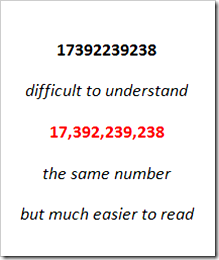 Though the comma is inserted into the visual form of the number, it has nothing to do with the digits or the value. The comma is a completely independent entity that retains its meaning at all times, regardless of where it is placed. The relationship between the Supreme Lord and the material world can be thought of in the same light. The entire creation, which includes everything matter and spirit, is part of God. The living entity, riddled by the possessive mindsets of “I” and “Mine”, is accustomed to viewing everything from a personal perspective. A wiser person will be able to view groups of individuals at a whole, while an even more intelligent person can see patterns over a large cross-section of groups. The paramahamsa, the spiritualist on the highest level of understanding, sees everything and every person as being equal, or part of God. If their abilities were to be explained in mathematical terms, we’d say that the paramahamsas can correctly identify any number without requiring commas or other tools that enhance readability. This is quite difficult to do, for the gross senses have a debilitating effect on one’s consciousness and mindset. A person who is truly liberated, one who is devoted to God and understanding His true nature, will be able to see everything, including large groups of living entities, in the proper context.
Though the comma is inserted into the visual form of the number, it has nothing to do with the digits or the value. The comma is a completely independent entity that retains its meaning at all times, regardless of where it is placed. The relationship between the Supreme Lord and the material world can be thought of in the same light. The entire creation, which includes everything matter and spirit, is part of God. The living entity, riddled by the possessive mindsets of “I” and “Mine”, is accustomed to viewing everything from a personal perspective. A wiser person will be able to view groups of individuals at a whole, while an even more intelligent person can see patterns over a large cross-section of groups. The paramahamsa, the spiritualist on the highest level of understanding, sees everything and every person as being equal, or part of God. If their abilities were to be explained in mathematical terms, we’d say that the paramahamsas can correctly identify any number without requiring commas or other tools that enhance readability. This is quite difficult to do, for the gross senses have a debilitating effect on one’s consciousness and mindset. A person who is truly liberated, one who is devoted to God and understanding His true nature, will be able to see everything, including large groups of living entities, in the proper context.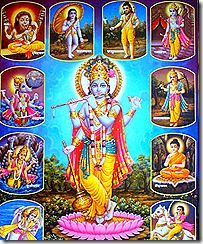 Though the Lord comes to this earth to give the conditioned souls a clearer understanding of the nature around them, He is not contaminated by matter in any way. He acts just like a comma inside of the digits representing a number, allowing others to correctly identify the different aspects of the world around them. Whether the comma is there or not has no bearing on the comma or the number. In the same way, Krishna’s creation remains the same whether He is personally present or not. After all, God is everything, so His presence is felt inside of every single atom. The incarnation is the more visible form, a way to unmistakably decipher who is God and who isn’t. The material world is full of puffed up living entities who claim to be God, who is the ultimate enjoyer and the greatest order supplier. Through the activities of the incarnations, one can understand that such individuals are simply cheaters who are destined to repeat the cycle of birth and death for many, many lifetimes.
Though the Lord comes to this earth to give the conditioned souls a clearer understanding of the nature around them, He is not contaminated by matter in any way. He acts just like a comma inside of the digits representing a number, allowing others to correctly identify the different aspects of the world around them. Whether the comma is there or not has no bearing on the comma or the number. In the same way, Krishna’s creation remains the same whether He is personally present or not. After all, God is everything, so His presence is felt inside of every single atom. The incarnation is the more visible form, a way to unmistakably decipher who is God and who isn’t. The material world is full of puffed up living entities who claim to be God, who is the ultimate enjoyer and the greatest order supplier. Through the activities of the incarnations, one can understand that such individuals are simply cheaters who are destined to repeat the cycle of birth and death for many, many lifetimes.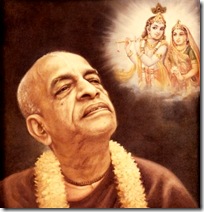 An example often invoked by His Divine Grace
An example often invoked by His Divine Grace 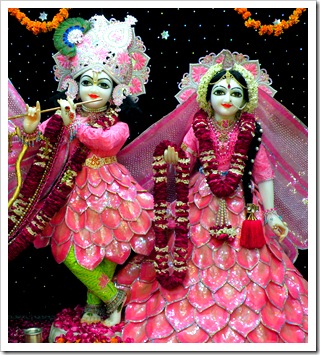 The purification of activity comes through acts of devotion. This discipline is known as bhakti-yoga, or
The purification of activity comes through acts of devotion. This discipline is known as bhakti-yoga, or 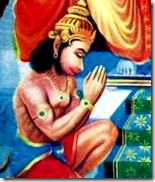 "Whom are you lamenting for when you yourself are pitiable? Why do you pity the poor when you yourself have now been made poor? While in this body that is like a bubble, how can anyone look at anyone else as being worthy of lamentation?" (Hanuman speaking to Tara,
"Whom are you lamenting for when you yourself are pitiable? Why do you pity the poor when you yourself have now been made poor? While in this body that is like a bubble, how can anyone look at anyone else as being worthy of lamentation?" (Hanuman speaking to Tara, 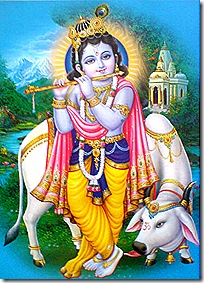 What causes class envy? First, we must acknowledge that life on earth is miserable. This doesn’t mean that every single person is full of misery, but rather, the end of everything, the ultimate conclusion or result of all activity, is misery. Man’s mortality is proof enough of this point. Those who are not spiritually inclined or those who are unaware of the ultimate objective in life take to fruitive activity as their main business. This engagement is referred to as karma in Sanskrit, and there is a reason that the word translates to “fruitive activity” in English. Karma is work performed that has desired and undesired consequences. The results of this work are referred to as phalam, or fruits; hence the term fruitive activity. Regardless of a person’s religious affiliation, age, or place of birth, there is the penchant for performing fruitive activity.
What causes class envy? First, we must acknowledge that life on earth is miserable. This doesn’t mean that every single person is full of misery, but rather, the end of everything, the ultimate conclusion or result of all activity, is misery. Man’s mortality is proof enough of this point. Those who are not spiritually inclined or those who are unaware of the ultimate objective in life take to fruitive activity as their main business. This engagement is referred to as karma in Sanskrit, and there is a reason that the word translates to “fruitive activity” in English. Karma is work performed that has desired and undesired consequences. The results of this work are referred to as phalam, or fruits; hence the term fruitive activity. Regardless of a person’s religious affiliation, age, or place of birth, there is the penchant for performing fruitive activity. The wealthy are deemed to be living the high life. “They have all the money in the world. What need do they have to worry about anything? They drive fancy cars, live in gigantic houses, and have beautiful members of the opposite sex flocking around them.” This viewpoint leads to envy, which then leads to a loss of rationality. Class warfare starts when the non-wealthy seek to punish the wealthy simply because of their financial disposition. “Oh they can afford to pay more. If I had that much money, I surely wouldn’t have a problem spreading the wealth around.” The opposing viewpoint is pity, a mindset adopted by the wealthy. The “poor” are deemed to be suffering; they are viewed as living the low life. “I can’t imagine not having a car and having to worry about how I’m going to eat every night. I feel so bad for them. No one should have to live like that, especially in today’s world where everyone else is so wealthy.”
The wealthy are deemed to be living the high life. “They have all the money in the world. What need do they have to worry about anything? They drive fancy cars, live in gigantic houses, and have beautiful members of the opposite sex flocking around them.” This viewpoint leads to envy, which then leads to a loss of rationality. Class warfare starts when the non-wealthy seek to punish the wealthy simply because of their financial disposition. “Oh they can afford to pay more. If I had that much money, I surely wouldn’t have a problem spreading the wealth around.” The opposing viewpoint is pity, a mindset adopted by the wealthy. The “poor” are deemed to be suffering; they are viewed as living the low life. “I can’t imagine not having a car and having to worry about how I’m going to eat every night. I feel so bad for them. No one should have to live like that, especially in today’s world where everyone else is so wealthy.”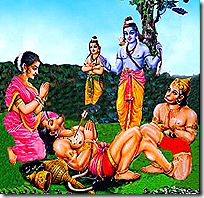 The time when it is most difficult to avoid pity is right after a love one has died, as was seen with Tara, the wife of the powerful monkey fighter Vali. During the Treta Yuga, the second time period of creation, Shri Rama, a non-different expansion of the Supreme Lord, appeared on earth and played the role of a pious
The time when it is most difficult to avoid pity is right after a love one has died, as was seen with Tara, the wife of the powerful monkey fighter Vali. During the Treta Yuga, the second time period of creation, Shri Rama, a non-different expansion of the Supreme Lord, appeared on earth and played the role of a pious  Shri Hanuman’s statement makes perfect sense, but actually applying the principles in real life is a different story. The end of Hanuman’s statement reveals the root cause of our problems: the bubble-like body. Everyone who resides in a body which is like a bubble is deemed to be equally worthy of lamentation. The real pitiable condition is the repeated cycle of birth and death. The supreme spiritual science of the Vedas confirms that the soul transmigrates from one body to another through the process of
Shri Hanuman’s statement makes perfect sense, but actually applying the principles in real life is a different story. The end of Hanuman’s statement reveals the root cause of our problems: the bubble-like body. Everyone who resides in a body which is like a bubble is deemed to be equally worthy of lamentation. The real pitiable condition is the repeated cycle of birth and death. The supreme spiritual science of the Vedas confirms that the soul transmigrates from one body to another through the process of 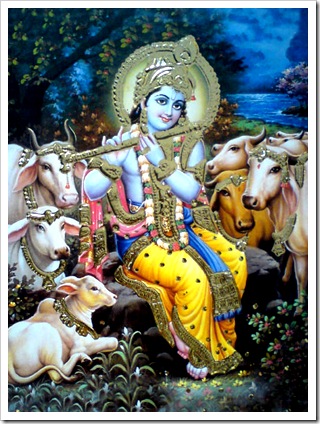 Fortunately, there is a way out of this cycle. Those who think of God at the time of death are guaranteed to get moksha, or the release from the wheel of material existence [samsara]. The way to guarantee remembering God at the time of death is to start thinking about Him now. There’s no time like the present, so we should all remember the Lord by regularly
Fortunately, there is a way out of this cycle. Those who think of God at the time of death are guaranteed to get moksha, or the release from the wheel of material existence [samsara]. The way to guarantee remembering God at the time of death is to start thinking about Him now. There’s no time like the present, so we should all remember the Lord by regularly  “O son of Kunti, I am the taste of water, the light of the sun and the moon, the syllable om in the Vedic mantras; I am the sound in ether and ability in man.” (Lord Krishna, Bhagavad-gita, 7.8)
“O son of Kunti, I am the taste of water, the light of the sun and the moon, the syllable om in the Vedic mantras; I am the sound in ether and ability in man.” (Lord Krishna, Bhagavad-gita, 7.8) To understand the nature of evidence, let’s work through a simple example of a situation that occurs quite frequently in real life. In America and other industrialized nations, automobile accidents are quite common. For those incidents involving two motorists who are behind the wheel, the causes and effects of the crash are quite obvious. Both parties perceived with their senses the events that led to the collision. In these instances, the evidence is the eyewitness account. Other times, however, there may not be any other parties around. The hit-and-run is a not so nice part of the life of a car owner. A person parks their car in a parking lot, goes into a store or shopping mall, and then returns to see that someone has hit their car. The other driver has left the scene, so there is no evidence showing who actually committed the crime.
To understand the nature of evidence, let’s work through a simple example of a situation that occurs quite frequently in real life. In America and other industrialized nations, automobile accidents are quite common. For those incidents involving two motorists who are behind the wheel, the causes and effects of the crash are quite obvious. Both parties perceived with their senses the events that led to the collision. In these instances, the evidence is the eyewitness account. Other times, however, there may not be any other parties around. The hit-and-run is a not so nice part of the life of a car owner. A person parks their car in a parking lot, goes into a store or shopping mall, and then returns to see that someone has hit their car. The other driver has left the scene, so there is no evidence showing who actually committed the crime. For the skeptic, successfully nullifying evidence is very easy. Everyone is prone to making mistakes, cheating, having imperfect senses, and being easily illusioned. To ere is human after all, so every one of us can make mistakes. Sometimes you can even have photographic evidence that is disputed. For example, in the National Football League, there are instant replay reviews of many controversial calls on the field. Invariably, there will be calls in a game where the announcers, referees, and players see the same video replay and reach different conclusions as to what occurred. Again, this speaks to the fact that every person has different sense perceptions, worldviews, ulterior motives, and levels of honesty.
For the skeptic, successfully nullifying evidence is very easy. Everyone is prone to making mistakes, cheating, having imperfect senses, and being easily illusioned. To ere is human after all, so every one of us can make mistakes. Sometimes you can even have photographic evidence that is disputed. For example, in the National Football League, there are instant replay reviews of many controversial calls on the field. Invariably, there will be calls in a game where the announcers, referees, and players see the same video replay and reach different conclusions as to what occurred. Again, this speaks to the fact that every person has different sense perceptions, worldviews, ulterior motives, and levels of honesty.
 At this point, the skeptic will argue that since the evidence provided by Vyasadeva describes events of the paranormal, such as talking monkeys and children lifting gigantic hills, it must be mythology or something untrue. In addition, the fact that no one can accurately date these events should only further discredit their authenticity. Some can’t even fathom that a single entity, one man, Vyasadeva, could have written so much in one lifetime. Therefore they even doubt the authenticity and existence of such a person. This behavior is quite humorous, as Vyasadeva’s greatness and authenticity of authorship is mentioned within the works themselves by exalted sages and respectable personalities.
At this point, the skeptic will argue that since the evidence provided by Vyasadeva describes events of the paranormal, such as talking monkeys and children lifting gigantic hills, it must be mythology or something untrue. In addition, the fact that no one can accurately date these events should only further discredit their authenticity. Some can’t even fathom that a single entity, one man, Vyasadeva, could have written so much in one lifetime. Therefore they even doubt the authenticity and existence of such a person. This behavior is quite humorous, as Vyasadeva’s greatness and authenticity of authorship is mentioned within the works themselves by exalted sages and respectable personalities. Many people saw Krishna and Rama directly and still didn’t believe that they were God. Such individuals didn’t even have to rely on the written word of Vyasadeva or the claims of evidence provided by others; they got to experience God’s splendor directly. During Lord Rama’s time, the Rakshasa demon Ravana failed to acknowledge Rama’s divine nature. The Rakshasa Maricha on one occasion had attacked the venerable Vishvamitra Muni during the time of a sacrifice. Rama, at the time a young child, was there with Vishvamitra to protect him. Shooting an arrow at Maricha, Rama launched the demon hundreds of miles away into an ocean. Thus Maricha had firsthand knowledge of Rama’s supreme powers. He subsequently warned Ravana not to anger the Lord or fight against Him. Maricha’s words were evidence of Rama’s divine nature, yet Ravana refused to accept them. In the end, this denial would cost him his royal opulence, worldwide fame, position as an object of fear, and ultimately, his life.
Many people saw Krishna and Rama directly and still didn’t believe that they were God. Such individuals didn’t even have to rely on the written word of Vyasadeva or the claims of evidence provided by others; they got to experience God’s splendor directly. During Lord Rama’s time, the Rakshasa demon Ravana failed to acknowledge Rama’s divine nature. The Rakshasa Maricha on one occasion had attacked the venerable Vishvamitra Muni during the time of a sacrifice. Rama, at the time a young child, was there with Vishvamitra to protect him. Shooting an arrow at Maricha, Rama launched the demon hundreds of miles away into an ocean. Thus Maricha had firsthand knowledge of Rama’s supreme powers. He subsequently warned Ravana not to anger the Lord or fight against Him. Maricha’s words were evidence of Rama’s divine nature, yet Ravana refused to accept them. In the end, this denial would cost him his royal opulence, worldwide fame, position as an object of fear, and ultimately, his life. For every individual, the authenticity of evidence is always determined by faith and authority. We view a person or entity as authoritative and thus believe whatever evidence they present to us. This is indeed the same tact followed by the devotees of Krishna. A follower of the Vedic tradition takes Vyasadeva, Valmiki, and other great saints as authority figures. Whatever evidence they provide is willingly accepted. But more important than evidence and faith is the action that is taken as a result. The unmatched, fixed transcendental position achieved by those who follow the prescriptions of the authorized acharyas is evidence enough of the authenticity of the Vedas and their founder.
For every individual, the authenticity of evidence is always determined by faith and authority. We view a person or entity as authoritative and thus believe whatever evidence they present to us. This is indeed the same tact followed by the devotees of Krishna. A follower of the Vedic tradition takes Vyasadeva, Valmiki, and other great saints as authority figures. Whatever evidence they provide is willingly accepted. But more important than evidence and faith is the action that is taken as a result. The unmatched, fixed transcendental position achieved by those who follow the prescriptions of the authorized acharyas is evidence enough of the authenticity of the Vedas and their founder. We willingly drive through intersections with green lights because we have faith in the previous evidence that was accumulated. This practice, when attached to the right type of evidence, can actually unlock the secret to the spiritual kingdom. Every one of us takes to activity with a desired positive outcome in mind. The nature of the positive condition can vary, but the end-goal is that of a favorable situation. When activities eventually lead to their intended goal, we develop faith in the evidence that served as the impetus for taking up that activity. In this way, we see that the only way to prove God’s existence is to take to the activities that He prescribes. For the people of this age, the great Vaishnava authorities, the devotees who have a firm belief in the existence of
We willingly drive through intersections with green lights because we have faith in the previous evidence that was accumulated. This practice, when attached to the right type of evidence, can actually unlock the secret to the spiritual kingdom. Every one of us takes to activity with a desired positive outcome in mind. The nature of the positive condition can vary, but the end-goal is that of a favorable situation. When activities eventually lead to their intended goal, we develop faith in the evidence that served as the impetus for taking up that activity. In this way, we see that the only way to prove God’s existence is to take to the activities that He prescribes. For the people of this age, the great Vaishnava authorities, the devotees who have a firm belief in the existence of  Everyone is looking for some pleasure, but the practices commonly adopted to secure such enjoyment fail in every regard. Even the engagements that do bring about some temporary happiness are riddled with negative side effects. The evidence provided by Vyasadeva and the Vedas in general are not meant to be accepted blindly. As mentioned before, any evidence, regardless of how obvious it may seem, can be invalidated through the use of skepticism. Therefore we should have some faith in the beginning and take to the recommended processes that constitute bhakti-yoga. Arjuna, Lord Krishna's dear friend, was always in the mindset of bhakti, so he was able to see Krishna for who He was, the Supreme Personality of Godhead. The proof is in the pudding, so if we follow the instructions of the spiritual masters and the Supreme Lord Himself, we will soon be able to tell for ourselves if the Vedas are authentic and if Krishna really is the ultimate reservoir of pleasure.
Everyone is looking for some pleasure, but the practices commonly adopted to secure such enjoyment fail in every regard. Even the engagements that do bring about some temporary happiness are riddled with negative side effects. The evidence provided by Vyasadeva and the Vedas in general are not meant to be accepted blindly. As mentioned before, any evidence, regardless of how obvious it may seem, can be invalidated through the use of skepticism. Therefore we should have some faith in the beginning and take to the recommended processes that constitute bhakti-yoga. Arjuna, Lord Krishna's dear friend, was always in the mindset of bhakti, so he was able to see Krishna for who He was, the Supreme Personality of Godhead. The proof is in the pudding, so if we follow the instructions of the spiritual masters and the Supreme Lord Himself, we will soon be able to tell for ourselves if the Vedas are authentic and if Krishna really is the ultimate reservoir of pleasure.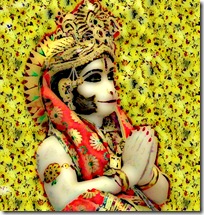 “Whom are you lamenting for when you yourself are pitiable? Why do you pity the poor when you yourself have now been made poor? While in this body that is like a bubble, how can anyone look at anyone else as being worthy of lamentation?” (Hanuman speaking to Tara,
“Whom are you lamenting for when you yourself are pitiable? Why do you pity the poor when you yourself have now been made poor? While in this body that is like a bubble, how can anyone look at anyone else as being worthy of lamentation?” (Hanuman speaking to Tara, 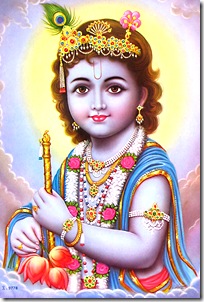 In the Vedic tradition, God’s ultimate feature is taken to be a transcendental form, a body which provides sweetness and unmatched pleasure to those qualified to see it. Why are there eligibility requirements in seeing God? By default, most people don’t want to see the Supreme Lord. If they saw Him they would have no desire to remain in a world that provides fleeting happiness, a place where misery is the end result of all activity. In order to see God in His original form, that of
In the Vedic tradition, God’s ultimate feature is taken to be a transcendental form, a body which provides sweetness and unmatched pleasure to those qualified to see it. Why are there eligibility requirements in seeing God? By default, most people don’t want to see the Supreme Lord. If they saw Him they would have no desire to remain in a world that provides fleeting happiness, a place where misery is the end result of all activity. In order to see God in His original form, that of 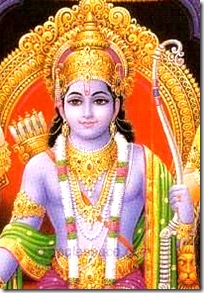 For those desiring transcendental pleasure, which is a hankering that always remains with the soul as its eternal characteristic, there is the original form of the Personality of Godhead, Shri Krishna, who has wonderful attributes of sweetness. These features carry over to His limitless personal expansions. One such form appeared on earth many thousands of years ago to give pleasure to the residents of the town of Ayodhya. As the courageous and pious prince of the Raghu dynasty,
For those desiring transcendental pleasure, which is a hankering that always remains with the soul as its eternal characteristic, there is the original form of the Personality of Godhead, Shri Krishna, who has wonderful attributes of sweetness. These features carry over to His limitless personal expansions. One such form appeared on earth many thousands of years ago to give pleasure to the residents of the town of Ayodhya. As the courageous and pious prince of the Raghu dynasty, 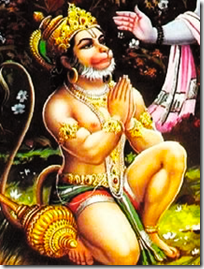 Hanuman starts out by asking a rhetorical question. “Why are you pitying someone else, when you are yourself worthy of pity?” Regardless of age, intelligence, financial disposition, or comfort level in life, there is always a tendency to pity others. We look at someone in a troubled situation and think, “Oh I feel so bad for that person. It’s such a shame what they have to go through. I can’t imagine how hard life must be for them.” This lamentation can be directed at a person who has just lost a loved one, gone through a messy divorce, is suffering through poverty, or has been embarrassed in front of others. When we see a public speaker start to stutter, stammer, sweat, and get nervous, we tend to cringe inside. “Oh boy, this is tough to watch”. These sentiments are evoked even from watching similar behavior depicted in fictional movies and television shows.
Hanuman starts out by asking a rhetorical question. “Why are you pitying someone else, when you are yourself worthy of pity?” Regardless of age, intelligence, financial disposition, or comfort level in life, there is always a tendency to pity others. We look at someone in a troubled situation and think, “Oh I feel so bad for that person. It’s such a shame what they have to go through. I can’t imagine how hard life must be for them.” This lamentation can be directed at a person who has just lost a loved one, gone through a messy divorce, is suffering through poverty, or has been embarrassed in front of others. When we see a public speaker start to stutter, stammer, sweat, and get nervous, we tend to cringe inside. “Oh boy, this is tough to watch”. These sentiments are evoked even from watching similar behavior depicted in fictional movies and television shows. The last part of Hanuman’s question is the kicker. This really gets to the heart of the point he’s trying to convey. The body is compared to a bubble, and since everyone lives in the same type of bubble, no one person is more worthy of lamentation than another. The bubble is a great analogy because it speaks to the temporary nature of the material body. By living for so many years, we may get fooled into thinking that the body is indestructible, or at the very least, that it is difficult to destroy. But in the grand scheme of things, the duration of life for the human being is nothing. It is paltry, pathetic, puny, and tiny compared to the duration of existence for the earth and other planets. When a bubble rises from the surface of water or is generated from soap, it is understood that it doesn’t have long to live. Indeed, the bubble can also be very easily broken. Simply swatting at the bubble or blowing air on it will disintegrate it within a second. When compared to the stability of larger land masses found in the material universe, the body of the human being is considered to be just as fragile as the bubble.
The last part of Hanuman’s question is the kicker. This really gets to the heart of the point he’s trying to convey. The body is compared to a bubble, and since everyone lives in the same type of bubble, no one person is more worthy of lamentation than another. The bubble is a great analogy because it speaks to the temporary nature of the material body. By living for so many years, we may get fooled into thinking that the body is indestructible, or at the very least, that it is difficult to destroy. But in the grand scheme of things, the duration of life for the human being is nothing. It is paltry, pathetic, puny, and tiny compared to the duration of existence for the earth and other planets. When a bubble rises from the surface of water or is generated from soap, it is understood that it doesn’t have long to live. Indeed, the bubble can also be very easily broken. Simply swatting at the bubble or blowing air on it will disintegrate it within a second. When compared to the stability of larger land masses found in the material universe, the body of the human being is considered to be just as fragile as the bubble.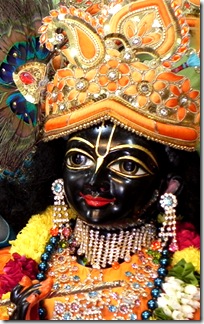 Since the body is just a bubble, the soul residing within it is certainly not worthy of lamentation. At the same time, if the body is just a bubble, what is the meaning to life? Why are we forced to live in such a fragile shell? Is there another type of body that we can occupy, something more sturdy and damage-resistant? To find the answer, we must revisit the issue of the personal form of God. Lord Shri Krishna, the ultimate feature of the Absolute Truth who is also known as Bhagavan, has an eternal body which is full of transcendental bliss and knowledge. Krishna’s beauty, knowledge, and bliss are not exclusively for His own benefit. Rather, others are meant to associate with this feature of the Lord, basking in the glory of the transcendental sweetness of Shri Shyamasundara.
Since the body is just a bubble, the soul residing within it is certainly not worthy of lamentation. At the same time, if the body is just a bubble, what is the meaning to life? Why are we forced to live in such a fragile shell? Is there another type of body that we can occupy, something more sturdy and damage-resistant? To find the answer, we must revisit the issue of the personal form of God. Lord Shri Krishna, the ultimate feature of the Absolute Truth who is also known as Bhagavan, has an eternal body which is full of transcendental bliss and knowledge. Krishna’s beauty, knowledge, and bliss are not exclusively for His own benefit. Rather, others are meant to associate with this feature of the Lord, basking in the glory of the transcendental sweetness of Shri Shyamasundara.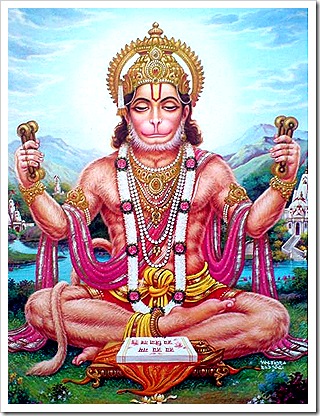 So how is God consciousness secured? For those who associated with Lord Rama during His time on earth, this consciousness was automatically adopted. The citizens of Ayodhya, Sugriva’s monkey army, and countless others were able to offer service to Rama directly, so their minds were always fixed on Him. The people of this age can associate with the same Lord Rama, and His original form of Krishna as well, by regularly
So how is God consciousness secured? For those who associated with Lord Rama during His time on earth, this consciousness was automatically adopted. The citizens of Ayodhya, Sugriva’s monkey army, and countless others were able to offer service to Rama directly, so their minds were always fixed on Him. The people of this age can associate with the same Lord Rama, and His original form of Krishna as well, by regularly